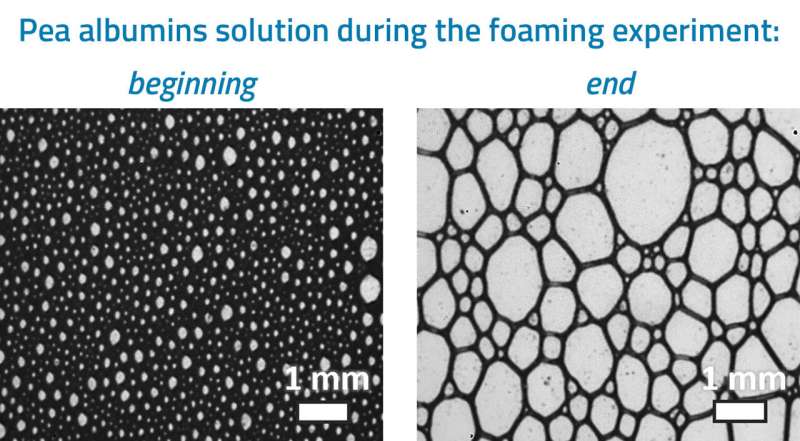Foams are an essential component of many different drinks and foods: from a frothy head of beer to coffee crema, bread and ice cream. Despite their ubiquity, little is actually known or understood about these highly complex systems.
Collaboration between the Institut Laue-Langevin (ILL) and Aarhus University has connected unique capabilities to investigate foam with critically relevant food science challenges, bringing a greener food future a step closer. The study is published in the Journal of Colloid and Interface Science.
Understanding the behavior of foam requires characterization of the structure. “That’s not easy,” explains Leonardo Chiappisi, ILL researcher and coordinator of the Partnership for Soft Condensed Matter (PSCM).
Firstly, because the relevant structural parameters of foam range from the macroscopic down to the nanometer scale. And secondly, due to the highly unstable nature of foam, which evolves through formation, drainage and collapse. “You’ve only got one shot to study the structure of a foam sample, yet no single technique can provide the information required across all the different length scales,” explains Chiappisi.
The ability to achieve a comprehensive and full-scale characterization of foam was achieved at the ILL by the design of an innovative experimental set-up, together with the development of methods to analyze the acquired data. “A sample of foam is generated within our device and the structure is then investigated in situ and across length scales by simultaneously performing small-angle neutron scattering (SANS), imaging and electrical conductivity measurements,” explains Chiappisi.

SANS reveals structural information about a sample by interpretation of the scattering pattern produced by the interaction of a beam of neutrons with the sample.
“SANS is the only technique capable of providing nano-scale structural information about foam,” explains Chiappisi. “The D22 and D33 diffractometers at the ILL are unusual, however, in that both are equipped with multiple detectors. This enables all relevant nanoscale structural information to be acquired in a single experiment, which is particularly critical for unstable systems such as foam.”
In addition, the relatively wide diameter of the neutron beam enables hundreds of foam bubbles to be probed at a time, resulting in statistically meaningful data without impacting the foam sample thanks to the non-damaging nature of neutrons. Essential insights across multiple length scales are gained by combining this advanced nano-scale data with optical imaging, while information about foam composition—essential for quantitative data analysis—is provided by electrical conductivity measurements.
The ILL is dedicated to delivering societal impact by extending access to the powerful techniques available at the institute to all relevant areas of applied science. The comprehensive foam characterization capabilities have thus been presented at a number of conferences, including the LINXS Northern Lights on Food Conference, which brings food science expertise together with knowledge about cutting-edge neutron and X-ray characterization methods.
“Food science involves very complex systems and multiple techniques are needed to measure samples in situ, with minimal disruption and across length scales in order to fully understand the structure, functionality and interactions of the different components,” explains Milena Corredig, Professor in the Food Science Department of Aarhus University. “I was very excited when I saw what Leonardo could do.”

The global shift from animal- to plant-based foods to improve diets and the sustainability of food production has created the need to improve understanding and accelerate development of plant-derived proteins and their associated processes. “We know how to whip cream but if you just transfer that process to plant-based proteins, the result is bad functionality, bad taste, bad texture, bad everything,” explains Corredig.
Combining their expertise, Chiappisi and Corredig worked to bring this greener food future a step closer, focusing first on pea albumin—a water-soluble protein extracted from peas that has been identified as a promising candidate for creating functional foaming ingredients in food.
“Food is basically soft matter and neutron scattering is a very powerful tool for studying soft matter materials,” explains Chiappisi.
“But coming from a food science background, it’s very difficult to translate our problem into a proposal for an experiment at a facility like the ILL; we don’t speak the same language,” explains Corredig. “I also don’t think in inverse Fourier transforms, so analyzing the scattering data is even harder.”
Collaboration between the ILL and Aarhus University—involving Ruifen Li (postdoctoral researcher at Aarhus University) and Julien Lamolinairie (Ph.D. student at the ILL)—has enabled the development of a common language to advance knowledge about foams made with pea albumins.
Significant work was first carried out at the PSCM to optimize ample preparation procedures, design and demonstrate the feasibility of the SANS investigation before requesting beamtime, as well as the development of a comprehensive model of pea albumin-based foams to ensure meaningful analysis of the acquired scattering data. The valuable insights provided by the comprehensive characterization of foams made with pea albumins bring pea-based cappuccinos one cup closer.
More information:
Ruifen Li et al, A time-resolved investigation at multiple-length scales of the structure of liquid foam stabilized by albumins from pea, Journal of Colloid and Interface Science (2024). DOI: 10.1016/j.jcis.2024.09.086
Provided by
Institut Laue-Langevin
Citation:
Pea-based cappuccino: Study investigates characteristics of foam (2025, February 4)
retrieved 4 February 2025
from https://phys.org/news/2025-02-pea-based-cappuccino-characteristics-foam.html
This document is subject to copyright. Apart from any fair dealing for the purpose of private study or research, no
part may be reproduced without the written permission. The content is provided for information purposes only.

